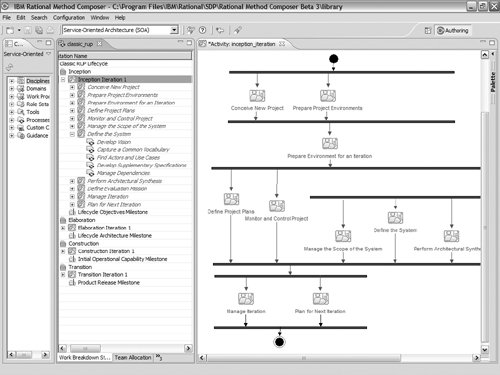| Delivery processes provide the project manager with a quick starting point. |
RMC focuses on addressing three critical areas for the project managers: rapid project initiation, flexibility, and reality-based management. Rapid project initiation. Once a decision has been made to initiate a project, time is usually a precious commodity. The purpose of the out-of-the-box delivery processes (see Figure B.3) is to provide the project manager with a quick starting point for planning and initiating a project. The delivery process will provide an initial project template, identify what type of project milestones to include, specify what work products to deliver at each milestone, and state what resources are needed for each phase. The integration between RMC and IBM Rational Portfolio Manager allows the manager to instantiate a project plan rapidly based on a starting template and project specifics. Microsoft Project plan templates can also be generated from RMC. Figure B.3. Delivery Process Depicted Graphically and as a Work Breakdown Structure.
A delivery process provides, among other things, a work breakdown structure that can be exported to IBM Rational Portfolio Manager and Microsoft Project. The delivery process also depicts graphically what activities and tasks should be done in what order, what work products and artifacts will be produced at what time, and what roles you need to staff at different stages of a project.  Flexibility. No two projects are alike; a project manager needs to modify the process rapidly to address specific project needs. He or she can do this through plug-ins and selectable method packages, allowing content around various domainssuch as database modeling or advanced requirements managementto be added or removed. Capability patterns allow project managers to add or remove quickly process patterns that pertain to specific problems. RMC also allows a project manager to modify rapidly any aspect of a delivery process. Reality-based management. Experience has shown that most detailed project plans produced at project inception are worthless halfway to completion. For this reason a delivery process is assembled from capability patterns. You can apply these process patterns as needed as you go through a project, rather than creating a detailed plan for the entire project up front. You can transfer delivery processes and capability patterns to RPM and instantiate your project plan in increments, one or a few capability patterns at a time. RPM provides a complete environment for managing RUP projects and makes it possible for (1) team members to understand what tasks are the most important, estimate time to complete tasks, and manage documents and reviews; and (2) project managers to distribute assignments, manage schedules and resources, and collaborate with the team to understand project issues. RPM also provides portfolio management capabilities, as well as enabling the entire team to view a variety of metrics related to project health and status, such as requirement and code churn, defect trends, and progress relative to the project/iteration plan. | RPM provides a complete environment for managing RUP projects. |
|